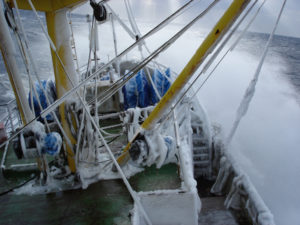
Two fishermen were rescued and five others are feared dead after a fishing boat sank in the Gulf of Alaska. At Maritime Injury Guide, we know that fishing and crab boat injuries are part of this dangerous industry. Our hearts go out to the families of the fishermen injured and killed in this tragic fishing boat sinking.
Fishing Boat Sinks on New Year’s Eve
On New Year’s Eve 2020, the 130-foot crab fishing boat Scandies Rose was traveling southwest of Kodiak, Alaska. The crew had loaded pots in Kodiak Harbor and was heading out to begin the winter season. At around 8 p.m., the captain called his ex-girlfriend to wish her a Happy New Year, and didn’t seem concerned about the ice and heaving waves. Fishing captains are used to this sort of weather and know when it is time to get to safety.
As the boat reached the southern edge of Sutwik Island, however, a mayday call was issued. At around 10:15 p.m. the crew reported the boat was taking on water. The call was relayed to the Kodiak search and rescue command center. Consequently, the U.S. Coast Guard dispatched an MH-60 Jayhawk helicopter to the area to attempt rescue.
Two fishermen were able to get into a lifeboat. After several hours they were rescued by the helicopter. They both suffered from hypothermia because of exposure to the poor weather conditions and were taken to the hospital for treatment. Survivors report that it was about 10 minutes from when the boat started listing (tilting to the side) to when they were in the water. The other five crewmembers were unable to reach the lifeboats and were considered missing.
The next day, the Coast Guard suspended the search. In a statement, Rear Admiral Matthew Bell, commander of the 17th district, said,
“The decision to suspend an active search and rescue case is never easy, and it’s only made after careful consideration of a myriad of factors. Our deepest condolences to the friends and families impacted by this tragedy.”
The other five crewmembers are feared dead. Some family members are holding out hope that they may have survived and may be unable to reach out.
Weather Conditions Contribute to Fishing Boat Sinking
At the time of the sinking, the weather was less than favorable. The National Weather Service had gale warnings in effect for most of the Alaska Peninsula. There were also freezing-spray warnings. In these conditions, a fishing boat can become almost encapsulated in ice as sea spray hits the decks and equipment and freezes in place.
Reports in the area at the time the fishing boat sank suggest 45-knot winds, 21-foot sea swells and freezing sea spray. The outside temperature was 15 degrees and the water temperature was around 40 degrees. The poor weather conditions are thought to have contributed to the fishing boat sinking, however there is an ongoing investigation into the cause. The Coast Guard says this process could take up to a year.
Dangers of Working on a Fishing Boat
The Occupational Safety and Health Administration (OSHA) lists commercial fishing, including crab fishing, as one of the most dangerous industries in the United States. OSHA and the Bureau of Labor Statistics compile data on the rate of injuries and fatalities in the fishing industry. Their data lists the following:
- From 2003 to 2009, there were 610 nonfatal injuries to fishermen. The most common causes of injury were:
- Contact with equipment or objects (33 percent)
- Overexertion (16 percent)
- Strains and sprains (33 percent)
- Between 2000 and 2014, there were 179 deaths in Alaskan fisheries.
- The Alaskan occupational group accounts for over 30 percent of fatal injuries in the fishing industry.
- The rate of fatal injuries among workers in the fishing industry is 203.6 per 100,000 workers. The rate among all other industries is 3.5 per 100,000 workers.
- Between 2010 and 2014, there were 66 vessel disasters in Alaskan waters, including:
- Vessel sinking
- Fires
- Events forcing crew to abandon ship
- The leading cause of fatal vessel disasters are instability and boats hit by large waves.
The U.S. Coast Guard also keeps records of vessel disasters. Their data shows:
- Between 1992 and 2007, there were 1,903 boats lost at sea.
- The boats lost at sea resulted in 934 fatal maritime injuries.
- Over the time period, an average of 58 fishermen died each year.
Workers in the Fishing Industry Have Rights
There is no doubt that the fishing industry is a dangerous one. Therefore, it is not surprising that there are maritime laws in place to help workers who suffer an injury. One of those laws is the Alaska Fishermen’s Fund. Alaska is the only state with this type of fund in place. Qualified fishermen can receive benefits for care and treatment of injuries sustained in Alaska.
Not all workers in the fishing industry qualify for benefits under the Alaska Fishermen’s Fund, however. Many workers will need to seek benefits or compensation through other laws, such as The Jones Act or the Longshore and Harbor Workers’ Compensation Act (LHWCA).
If you work in the maritime industry, the best way to find out what your options are for compensation after a work injury is to contact a maritime injury attorney. At Maritime Injury Guide, we can certainly help you understand and protect your rights, and determine the best options to recover from an occupational injury.
To learn more, or to request a free injury consultation, call us at 1-866-871-8422, or complete our online contact form.
Sources:
- https://www.adn.com/alaska-news/2020/01/02/crab-boat-that-sank-on-new-years-eve-leaving-5-presumed-dead-was-headed-into-area-under-gale-warning/
- https://www.cdc.gov/niosh/docs/2017-171/pdf/2017-171.pdf?id=10.26616/NIOSHPUB2017171
- https://www.bls.gov/opub/btn/volume-1/facts-of-the-catch-occupational-injuries-illnesses-and-fatalities-to-fishing-workers-2003-2009.htm
- https://www.cbsnews.com/news/alaska-fishing-boat-sinks-5-crew-members-feared-dead-2020-01-02/